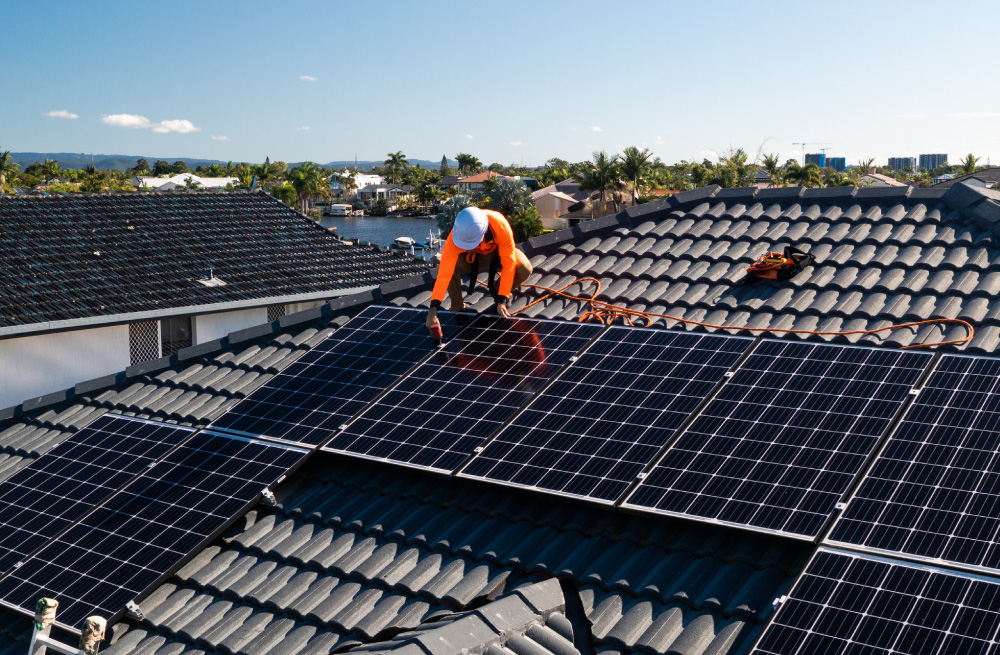CHAPTER 4: HOW TO GET OFF GAS
Consider solar installation
Why go solar?
Combining rooftop solar with all-electric appliances allows you to use the energy you generate onsite. About one in every three Australian homes has solar panels on the roof. With government-based incentives that reduce the purchase price, a new solar system can pay off financially—where energy cost savings equal upfront system costs—in around five to six years in most cases. Even without incentives, payback can occur in less than 10 years.
With current technology costing around $1 per watt of capacity installed, there is little advantage to waiting for technological improvements, as gains are likely to be incremental. A solar system can greatly reduce your electricity bill, even to the point where you receive bills with little or nothing to pay—or even get into credit if you have a larger system, particularly over summer.
A grid-connected solar system means you can sell excess electricity that you generate to your electricity retailer for a rate per kilowatt-hour (kWh), known as the feed-in-tariff (FIT). The solar FIT appears as a credit on your electricity bill and is paid to you from your electricity retailer, usually at a set rate per kilowatt hour. Feed-in tariff rates (payment amounts) and eligibility will change depending on:
- The amount of solar-generated electricity you feed back into the grid;
- The state you live in;
- When you installed your solar PV system;
- Local grid conditions.
As the proportion of solar generation in the electricity system increases, the value of feed-in-tariffs is tending to decrease. The value of rooftop solar is in self-consumption and is highly complementary to all-electric homes. You can maximise the use of solar (and therefore minimise bills) by timing appliances to run in the middle of the day; for example, it is recommended to run heat pump hot water tank storage systems in daytime hours or charge an electric vehicle.
If you have a single-phase supply, like most residential houses, there is a good chance you will be limited to a 6.6kW solar PV system (an oversized array with a 5kW inverter). If you want to go above 5kW then you will have to ask the installer to limit the exports to 5kW, or upgrade to a three-phase supply. Have a chat with the installer to see if you’ll have a limit of 5kW or higher.
Finding solar installers
Consumers are increasingly looking for approved solar retailers as a way of ensuring they are purchasing their solar and storage from a company they can trust. The New Energy Tech Consumer Code ensures consumer protection standards for solar, battery storage, EV chargers and more. The NETCC standards mean the products are designed by peak industry and consumer bodies, they are authorised by the Australian Competition & Consumer Commission (ACCC) and provide standards for the complete customer journey.
Look for a solar professional to assess where shadows of nearby trees and buildings may fall on your solar array in the wintertime. Assessors can use solar tracking programs to figure out where the shadows will fall throughout the day and in all seasons. You can also check and see if your place shows up on Google’s Project Sunroof map, which gives solar capacity estimates based on satellite imagery.
It is also common practice for solar providers to ask potential clients for a copy of their electricity bill. With this information, a solar installer can calculate the size of a PV array and inverter that will bring your bill close to a net annual zero cost.
You can compare quotes and potential solar deals in your area here.
Solar Rebates
Government funded programs are available to help residents access solar across a range of locations, incomes and dwelling types. Solar rebates reward solar customers for generating their own energy. They were originally introduced as an incentive to encourage households and businesses to purchase solar panels, as the large up-front costs can be discouraging to bill-payers. Solar panel rebates can assist in paying off these systems more efficiently.
Some programs, like Solar Homes in Victoria, help residents cover the upfront costs of purchasing solar PV and in some cases extending to solar hot water, solar for rentals, solar batteries and zero emissions vehicles. Solar Victoria’s program for solar for rental properties includes a rebate and advice on structuring agreements between renters and landlords. You can download the Solar Made Simple guide to understand the details on how to install solar to your home, the eligibility requirements, and get a quote.
Once installed, you can monitor the energy flows from the panels, to/from the grid and/or battery with apps in real or historical time.
See below for a guide to finding out about the current rebates available across Australia.
Geordie’s House by Emma Scragg Architect was featured as part of Sustainable House Day 2023. Watch a house tour video here.
Adding a battery
Adding a battery to your solar system is one way to use more of the solar you generate. A solar battery lets you store the surplus electricity your panels create, so you can use it later in the day, and can, in fact almost double how much solar you use. Figures from the Climate Council show that adding a 4kWh battery to a 5kW residential solar system can increase the amount of self-generated solar electricity a household consumes from 30% to 60%.
If you’re mainly interested in reducing your carbon footprint, then adding a solar battery to your home solar system is probably a natural next step. It may also be the right decision if you’re interested in saving money and reducing your energy bills. Nonetheless, the upfront cost of home solar batteries remains relatively high, with payback periods typically amounting to 15-20 years.
To make sure it’s a sound financial decision, it’s important to weigh up the total cost of the solar battery and its installation against how much you’re likely to save over time. Whether it’s the right choice for you will depend on your personal consumption patterns, circumstances and motivation. It’s a good idea to get advice from a reputable retailer who can help you to decide if installing a solar battery to your solar system is a good idea for you right now and if so, what options will best suit your needs. You can also calculate your energy use using Renew’s Sunulator platform.
Green Loans
Depending on where you live, green loans may be available for you and your household. A solar loan is a type of financing that enables individuals or businesses to install a solar energy system on their property by borrowing money from a lender. The loan is specifically designed to cover the upfront costs associated with purchasing and installing solar panels, inverters, and other equipment necessary for generating electricity from the sun.
Green lending offers a very attractive rate because you are limited to purchases. A green loan is a form of credit that a financial institution offers to a customer on the condition that they utilise the funds for a purpose that the lender deems to be environmentally beneficial.
The 2023/23 Federal Budget provided $1 billion in finance through the Clean Energy Finance Corporation for loans to support electrification and energy efficiency. These loans are likely to be provided by banks and other financial institutions to households.
Although the products you can buy with a green loan may differ between lenders, you can generally use one to purchase items that consume less energy or water, lessen your reliance on the grid, or lessen pollution. If the purchase you have in mind is eligible for a green loan, it is a good idea to speak with your lender directly. For instance, the item could have to achieve a specific star rating for energy efficiency. This includes:
- Purchasing certain eco-friendly products for your home;
- Buying a more environmentally friendly vehicle, such as an electric or hybrid;
- Solar panels, hot water systems, pool heaters or battery systems;
- “Green”, eco-friendly or electric vehicle;
- Double glazing for windows or external awnings;
- Water tanks;
- Insulation;
- Grey water treatment system;
- Energy-efficient appliances and white goods;
- Energy-efficient electric heaters or split systems, evaporative coolers or energy-efficient air conditioners;
- Home ventilation systems.
Renew also has a number of online articles that may assist to plan your solar system and installation.














